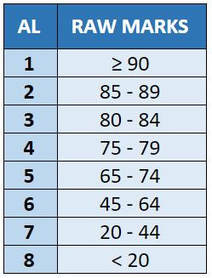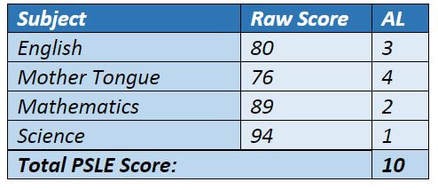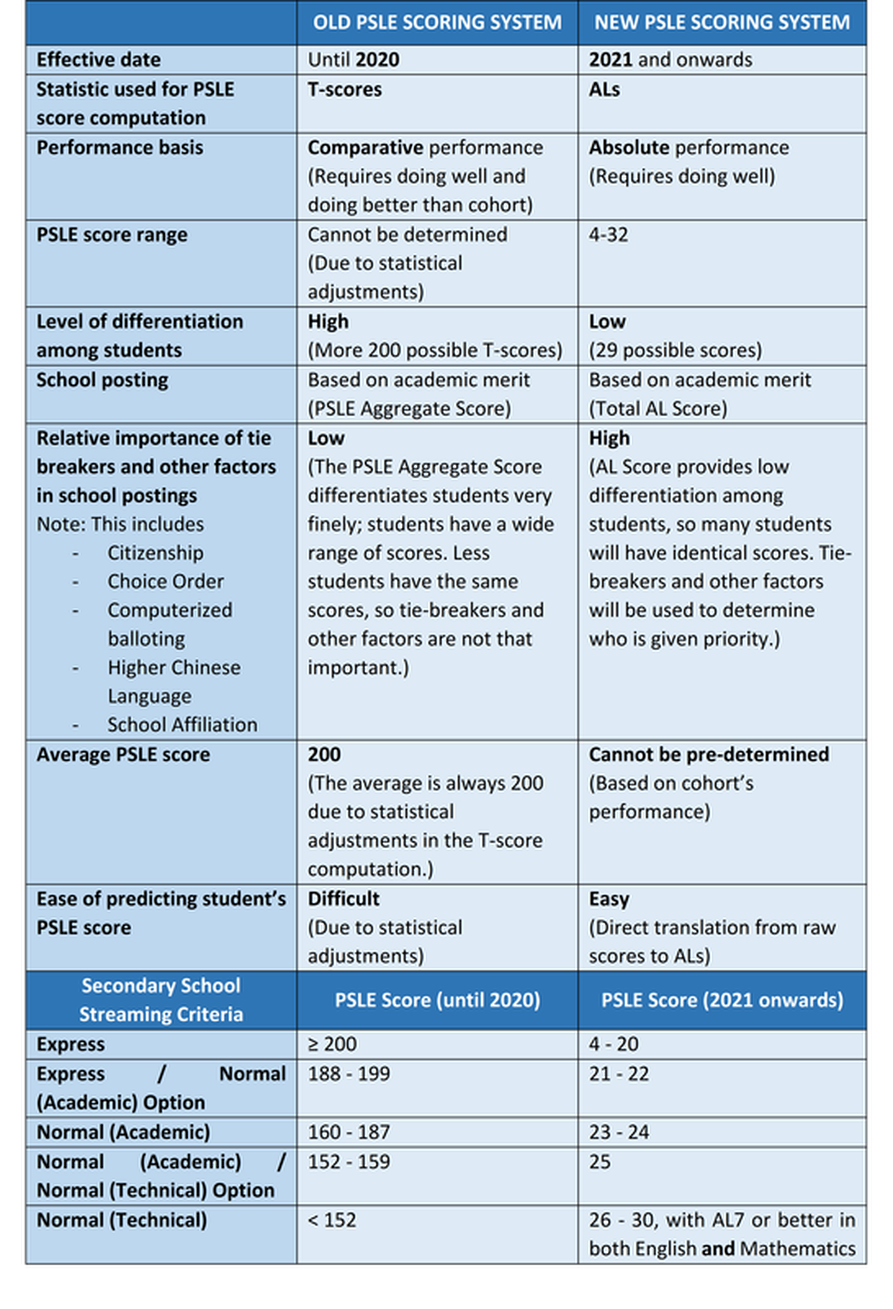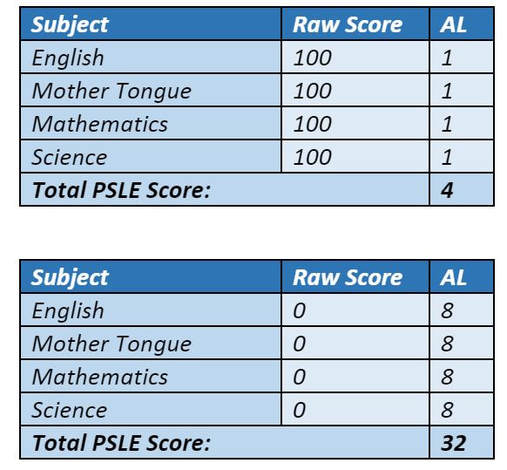|
What is the new PSLE scoring system? How will the new PSLE scores be calculated/determined? Does my child’s approach to PSLE need to change with the change in the scoring system? My child is now in Primary XX. Will she be affected by the changes? How does the new PSLE scoring system affect my child’s streaming? On 13 July 2016, MOE announced that the current PSLE T-score system will be replaced with Eight scoring bands known as Achievement levels (ALs). The change takes effect in 2021, which means that those who are taking PSLE in 2021 and onwards will be scored using this system. Since then, we have seen a flurry of questions raised by concerned parents on how this would affect them. Earlier on, we provided a comprehensive guide of the current T-score based PSLE scoring system. Now, we provide a comprehensive guide on the new PSLE scoring system. We also share what this means for you and address some common questions about the changes! HOW DOES THE NEW PSLE SCORING SYSTEM WORK? Step 1: Your child sits for the PSLE examinations, does her best, and obtains her raw marks. Step 2: Her raw mark for each subject is converted into a scoring band called an Achievement Levels (AL), with AL1 being the best score and AL8 being the lowest score. The conversion table is as such: Step 3: The ALs for all subjects are summed. The total is your child's PSLE Score! Thus, the new PSLE Score will range from 4 (best) to 32. Here is an example calculation of the PSLE Score using ALs: HOW IS THE NEW PSLE SCORING SYSTEM DIFFERENT FROM THE T-SCORE SYSTEM? A comparison between the old and new PSLE scoring system is provided in the table below: WHAT ARE THE KEY FEATURES OF THE NEW PSLE SCORING SYSTEM? Non-comparative scoring. As described in our earlier post, the current PSLE Aggregate Score is based on T-scores, which are comparative scores that pits your child’s performance against her cohort. A student who scores well for all her subjects may still receive a lower T-score if the rest of her cohort scores better. Thus, she needs to do well and do better than her peers in order to achieve a good PSLE Aggregate Score. The new scoring system removes this comparative element, as raw scores are now converted directly into ALs; it does not matter how well her cohort performs! ALs reflect a student’s own level of achievement, instead of comparing her to her peers. Thus, she simply needs to do well to achieve a good PSLE score! Reduced differentiation among students. With the wider scoring bands, students will be less differentiated amongst each other compared to the T-score based system that pits the student against the cohort. The new PSLE Score will range from 4 (best) to 32, which means that there are 29 possible PSLE Scores. This is a marked reduction from approximately 200 different T-scores today. WHY WERE THESE CHANGES MADE TO THE PSLE SCORING SYSTEM? The reasons for the changes are directly related to the two primary features we highlighted above – non-comparative scoring and reduced differentiation among students. In the new scoring system, a student will score an AL based on how well she has met the learning objectives of the curriculum. This therefore removes the pressure on the student to outperform others, therefore allowing her to focus on her own learning outcomes and achievement. MOE states that “once a student shows a level of achievement that meets the learning objectives of the curriculum expected at a certain AL, he will receive the AL regardless of how his peers perform. The emphasis is on how well the student has learnt, and not how well he has done compared to others. We want our children to focus on their own learning instead of trying to outdo others.” Additionally, some argue that the level of differentiation among students using the T-score system is unnecessarily excessive and not meaningful. A student who scores 240 is perceived as better than a student who scores 239, but it is not educationally meaningful to differentiate so finely between the two. In contrast, the wider scoring AL bands would place students who are academically similar in the same category. SECONDARY SCHOOL STREAMING CRITERIA Continued focus on academic merit. As shown in the table above, the streaming practice will remain in place and continue to be based on academic merit. The current and new streaming criteria is shown below and will take effect together with the new PSLE scoring system in 2021. Introduction of choice order as a new tie-breaker. Additionally, from 2021, the order of preference for secondary schools will be taken into account for secondary school admissions. Students will submit a list of six schools in order of preference. A student who has placed a school as a first choice will get priority over another student who has the same PSLE score but listed the same school as her second choice. If both students have the same PSLE score, citizenship status and listed a school in the same choice order, computerised balloting will be used as a tie-breaker. WHAT DOES THE NEW PSLE SCORING SYSTEM MEAN FOR ME? Actually, it means little (or at least it should)! Regardless of whether or not the PSLE Score is comparative, the most important thing is (and has always been) for your child to give her best during her PSLE examinations! We believe the focus should never have been to outperform others regardless of the scoring method. We strongly encourage parents not to be too absorbed in or distracted by the details of PSLE scoring. The best thing you can do is to focus on helping your child to do her best! We will be talking more about this in an upcoming post on shaping your child’s goals and motivation to excel by encouraging effort, not results, so keep checking back for more content! Having said that, there are a few things to take note of. Greater importance of tie-breakers. As students will be less differentiated in their PSLE scores, tie-breakers will become far more important than before in determining your child’s secondary school admission. This includes the aforementioned tie-breakers which are (1) Citizenship – Singaporeans get priority; (2) Choice Order; and (3) Computerised Balloting. Among these factors, Choice Order is that most controllable. Students and parents will have to choose and rank order their desired secondary schools much more carefully than before. Greater importance of other factors. Similarly, other factors that provide an advantage for secondary school postings become far more important with the reduced differentiation. When applying to SAP schools, students who have taken Higher Chinese Language (HCL) will receive an advantage. Among students who obtain the same PSLE score and are competing for the same spot in an SAP school, those who have better HCL scores will be given priority over those with poorer HCL scores or did not take HCL. Also, admissions by affiliation will remain in the new PSLE system. Students who are applying to an affiliated school will be granted priority if they indicated the school as their first choice. Larger choice of schools for students. Given the reduced differentiation of PSLE scores, schools with similar academic profiles will be less differentiated by cut-off points. Thus, a wider range of schools will be available to any particular student and she will have greater freedom of choice to consider other factors such as personal preference, cultural fit, distance from home etc. WAIT! I STILL HAVE MORE QUESTIONS! Sure! We address some common questions here: 1. What is the best/worst possible PSLE score in the new PSLE scoring system? The best possible score is 4, while the worst possible score is 32! To see how this works, consider two students who score 100 and 0 on everything: 2. Will there still be letter grades assigned to each subject, such as A and A*?
The new scoring system will not involve any letter grades. Only ALs will be assigned for each subject. 3. Can you help me estimate my child’s PSLE score? She usually gets (so and so) marks. The new AL-based system makes it a lot easier to estimate your child’s PSLE score, since her raw marks are directly translated into ALs which are then are summed into the PSLE score. You may refer to the first section on “HOW DOES THE NEW PSLE SCORING SYSTEM WORK?” to learn how to do an estimation! 4. My child is exempted from Mother Tongue. How will her PSLE score be calculated? According to MOE, students who have been granted an exemption from Mother Tongue will be assigned an AL score for her Mother Tongue that takes reference from those of her peers who were (1) offered Mother Tongue; and (2) who have similar AL scores in the other three subjects of English Language, Mathematics and Science. In other words, the non-exempted students who performed similar to her for her remaining three subjects are used as a proxy to assign her an AL score for Mother Tongue. The assigned AL score for Mother Tongue will be added to her AL scores for the other three subjects to obtain the student’s final PSLE score. 5. What is the average PSLE score under the new PSLE scoring system? The new scoring system is non-comparative and reflects a student’s own performance. The average PSLE score will therefore be dependent on the cohort’s performance and will differ across cohorts. It is impossible to pre-determine what the average PSLE score will be for a particular year. 6. Under the new PSLE scoring system, how do I know if my child did better than others or not? The new scoring system is non-comparative and reflects your child’s own performance, not that of her cohort. Thus, the only way to know if your child did better or worse than others would be to (1) look at her AL - MOE has stated that on average, about half of the students will score AL4 or better; (2) look at her streaming placement, which serves as an indirect indicator or her relative performance; and (3) look at national statistics released by MOE, though it is unclear at this point whether such statistics will be available. 7. My child is now in Primary XX. Will she be affected by the changes? Your child will be affected by the changes if she takes her PSLE in 2021 and onwards. 8. My child is a top-scorer and would have achieved a high PSLE score under the T-score system. With the wider AL bands, how should she compete against other top-scorers? With the reduced differentiation among students, top-scorers will find themselves placed in the same category at AL1. Your child may have to take on additional commitments to increase her chances of attaining a spot in her desired secondary school. One way to do this is to take on Higher Chinese (HCL). When applying to SAP schools, students who have taken HCL will receive an advantage. Among students who obtain the same PSLE score and are competing for the same spot in an SAP school, those who have better HCL scores will be given priority over those with poorer HCL scores or did not take HCL. Also, as explained above, her indicated choices of schools will be highly important in determining the priority given to her. Lastly, admissions by affiliation will remain in the new PSLE system. Students who are applying to an affiliated school will be granted priority if they indicated the school as their first choice. 9. Will the PSLE curriculum change due to the new scoring system? MOE has indicated that the new scoring system will not affect the curriculum, the subjects tested at the PSLE or the demand of the PSLE on students. Nonetheless, MOE will continue its current practice of reviewing the curriculum regularly to ensure its relevance. 10. What if my child does not meet any of the streaming criteria? We hope this does not happen to anyone, but if your child gets AL8 for English or Mathematics, or has a PSLE score of 31 or 32, she would have to either retake the PSLE, or join the NorthLight School or Assumption Pathway School which are specialised secondary schools for those who did not pass their PSLE. 11. Why are there 8 ALs? Why not more or less? The number of ALs determine the level of differentiation among students. If students are differentiated too finely (more ALs), it causes excessive stress on the student to score that one additional mark even though it is not educationally meaningful. If students are differentiated too broadly (less ALs), students who are academically different will be put in the same programmes. This means that some students will be overchallenged and discouraged while others will not be underchallenged and not reaching their potential. Also, it will cause greater usage of randomised computerised balloting as a tie-breaker. MOE deemed that having 8 ALs provides a good balance between overly fine and overly broad differentiation among students. Thus, the 8 ALs are designed to reflect broadly different levels of achievement. A closing note As we have mentioned earlier, the change in PSLE scoring should mean little to your child's studies and the most important thing is (and has always been) for your child to give her best during her PSLE examinations! At Polymath Learning Centre, we believe that the focus of education should be to nurture the character, aptitude and attitude of children to give them the best chances of success in the future, not just in school but also in life. Good results and high scores are a natural consequence of successful education, not the other way around. The best thing we can do is to focus on helping your child to do her best! We discuss this further in our other blog posts so do give them a read. If you're curious to find out more about our approach, feel free to contact us or sign up for a free trial lesson today! |





 RSS Feed
RSS Feed